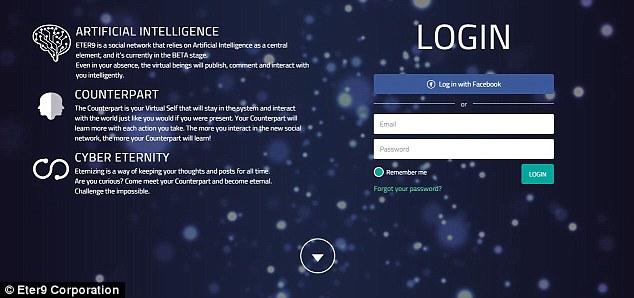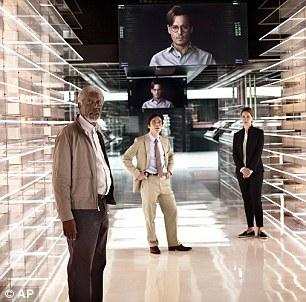Well, the short answer to the titular question is: no.
Sorry. However, some are suggesting that it could bring something akin to it in the form of an interactive virtual avatar that gives presence to those who have passed away. The idea behind this is that by collecting information that a person generated during their lifetime, a digital model of that person could be created that would be available for interaction even after that person no longer existed in the physical world.
 My first reaction to this is that it would make an excellent plot for a science fiction film. My second reaction was disappointment because what I thought was my million dollar idea turns out to have already been made as the film Transcendence. My third reaction? I need to get a babysitter so I can go out to the movies more often.
My first reaction to this is that it would make an excellent plot for a science fiction film. My second reaction was disappointment because what I thought was my million dollar idea turns out to have already been made as the film Transcendence. My third reaction? I need to get a babysitter so I can go out to the movies more often.
In any case, lecturer Simon McKeown of Teesside University in the UK thinks that such a life database avatar might be part of our everyday experience of memory collection within the next fifty years. For as long as human beings have been able to handle the idea of object permanence, we have been seeking ways to remember those who are no longer with us, whether through tokens, drawings, photographs, videos, or any number of other methods of memory capture. Efforts have been made across time and culture to make contact with the dead (also a popular movie plot), but unless you possess the sixth sense, there is something stale about the images we have, even if they are moving pictures.
Advocates of this avatar-based approach to reviving the dead would like to see computers be able to create synthetic digital life in order to keep in touch with our lost loved ones. One of the factors that contributes to making this idea more than just a fantasy is the vast amount of data people are recording and sharing through social media. Combine this with advanced 3D modeling technology and we might even be able to create an avatar that could respond to new situations and continue to evolve.
McKeown’s efforts in this area have led to the development of a project he calls ‘Preserved Memories’ for which he boasts:
“In the future with Preserved Memories, you will never have to experience the loss of a loved one. You will be able to add to your family tree and select new family members, including famous faces and legends, all of whom will already know about you. Using emotion-sensitive human-computer interaction our artificially intelligent participants continue to acquire ongoing knowledge long after their death – they evolve digitally and do not die.”
It seems to me, however, that McKeown fundamentally misunderstands human attachment. After all, it isn’t the social media presence of my husband that endears him to me, it is his presence – the one thing that can never, ever be recreated. I’m not saying that this, what amounts to a long distance relationship, wouldn’t be something I might find comforting or appealing were he gone, but the idea that I would not experience loss simply because I could interact with an avatar makes me question not only McKeown’s sanity, but also his ability to form human bonds.
 There is nothing wrong with seeking ways to ease the pain and deal with the trauma of loss and what I’m hoping we have here is a classic case of over-selling an innovation. This type of avatar certainly could provide another way for people to continue to interact with their memories although it is possible to argue that such a product could be unhealthy (although that’s what they say about bacon and I still can’t resist it). It is incredibly difficult to realize that when someone has died they are truly gone forever and I wish that I could say that this type of innovative idea would provide a bit of eternal life, but it’s rather more likely that it simply clarifies the absence of the person.
There is nothing wrong with seeking ways to ease the pain and deal with the trauma of loss and what I’m hoping we have here is a classic case of over-selling an innovation. This type of avatar certainly could provide another way for people to continue to interact with their memories although it is possible to argue that such a product could be unhealthy (although that’s what they say about bacon and I still can’t resist it). It is incredibly difficult to realize that when someone has died they are truly gone forever and I wish that I could say that this type of innovative idea would provide a bit of eternal life, but it’s rather more likely that it simply clarifies the absence of the person.
 We have a habit these days of looking to technology to save us from everything, in the end though, we might be better off making sure we enjoy those we have while we are here and creating the memories of our interactions that will help comfort us when they are gone. In fact, I think I’m going to turn off my computer right now and go have a snuggle, because there’s nothing but presence that can ever provide that. Let’s hear your thoughts on this story in the 3D Printing and Longevity Forum thread on 3DPB.com.
We have a habit these days of looking to technology to save us from everything, in the end though, we might be better off making sure we enjoy those we have while we are here and creating the memories of our interactions that will help comfort us when they are gone. In fact, I think I’m going to turn off my computer right now and go have a snuggle, because there’s nothing but presence that can ever provide that. Let’s hear your thoughts on this story in the 3D Printing and Longevity Forum thread on 3DPB.com.
Subscribe to Our Email Newsletter
Stay up-to-date on all the latest news from the 3D printing industry and receive information and offers from third party vendors.
You May Also Like
Profiling a Construction 3D Printing Pioneer: US Army Corps of Engineers’ Megan Kreiger
The world of construction 3D printing is still so new that the true experts can probably be counted on two hands. Among them is Megan Kreiger, Portfolio Manager of Additive...
US Army Corps of Engineers Taps Lincoln Electric & Eaton for Largest 3D Printed US Civil Works Part
The Soo Locks sit on the US-Canadian border, enabling maritime travel between Lake Superior and Lake Huron, from which ships can reach the rest of the Great Lakes. Crafts carrying...
Construction 3D Printing CEO Reflects on Being Female in Construction
Natalie Wadley, CEO of ChangeMaker3D, could hear the words of her daughter sitting next to her resounding in her head. “Mum, MUM, you’ve won!” Wadley had just won the prestigious...
1Print to Commercialize 3D Printed Coastal Resilience Solutions
1Print, a company that specializes in deploying additive construction (AC) for infrastructure projects, has entered an agreement with the University of Miami (UM) to accelerate commercialization of the SEAHIVE shoreline...






























